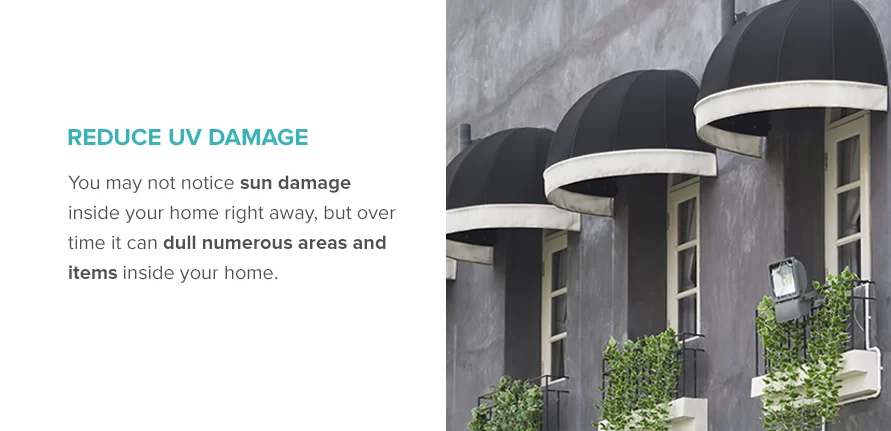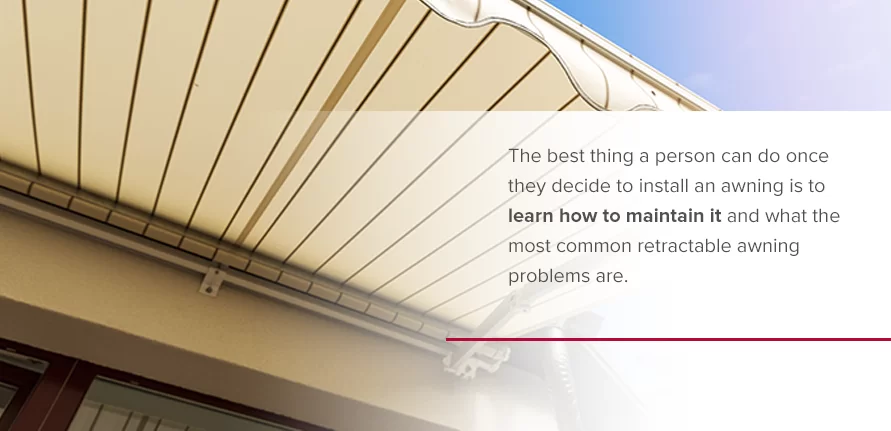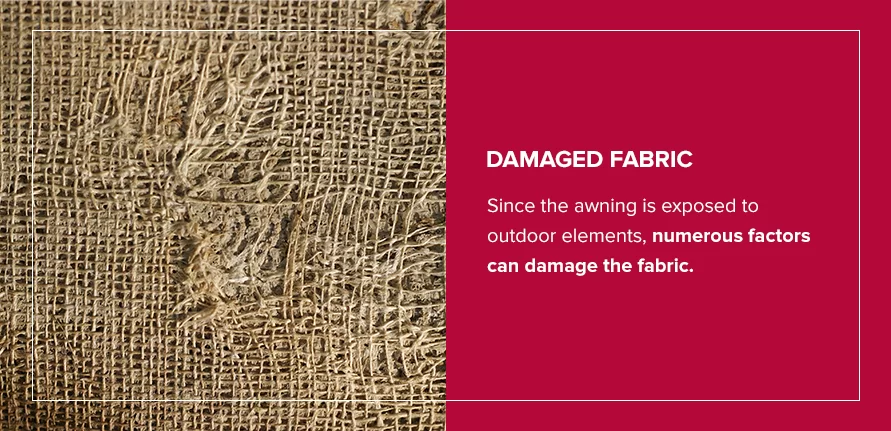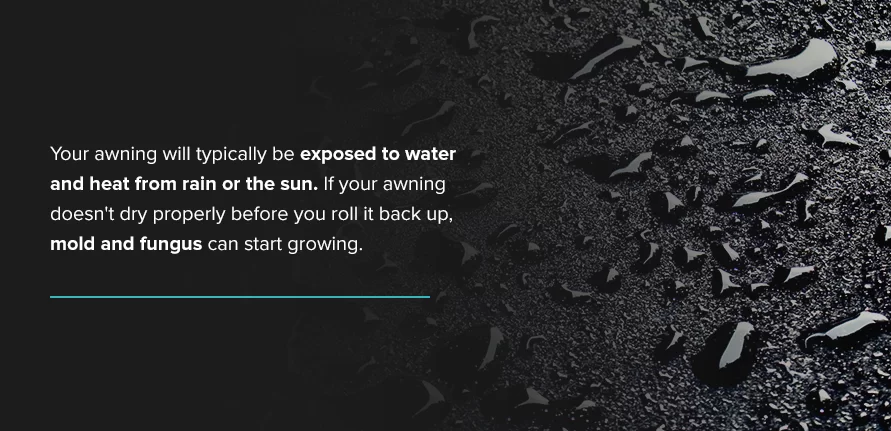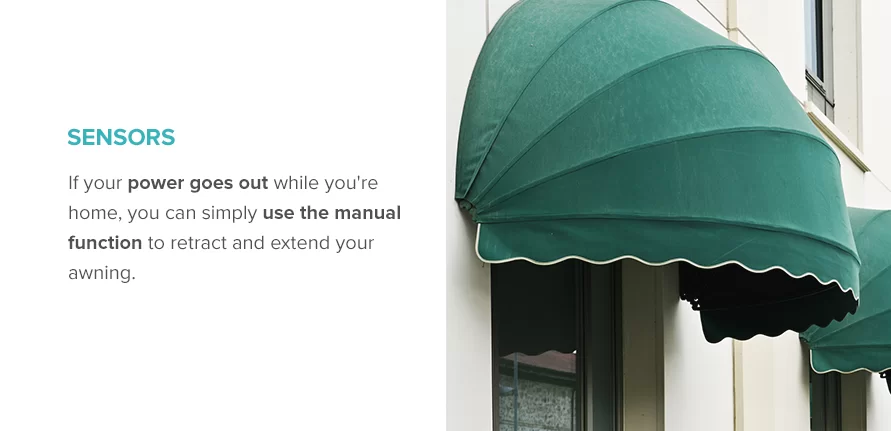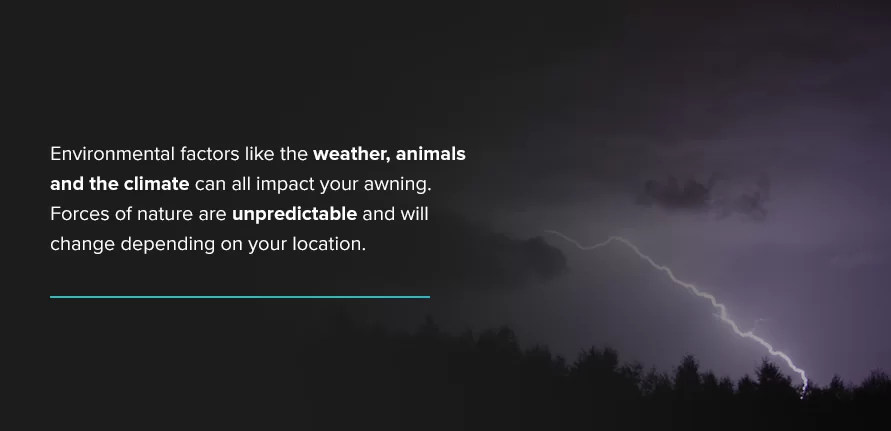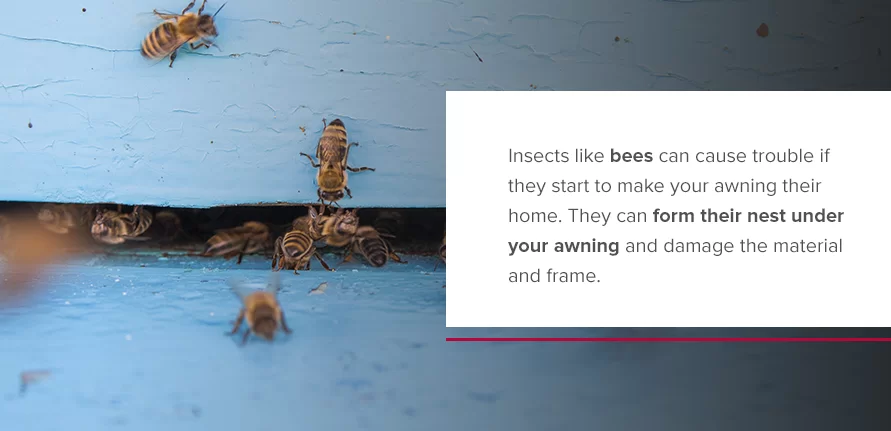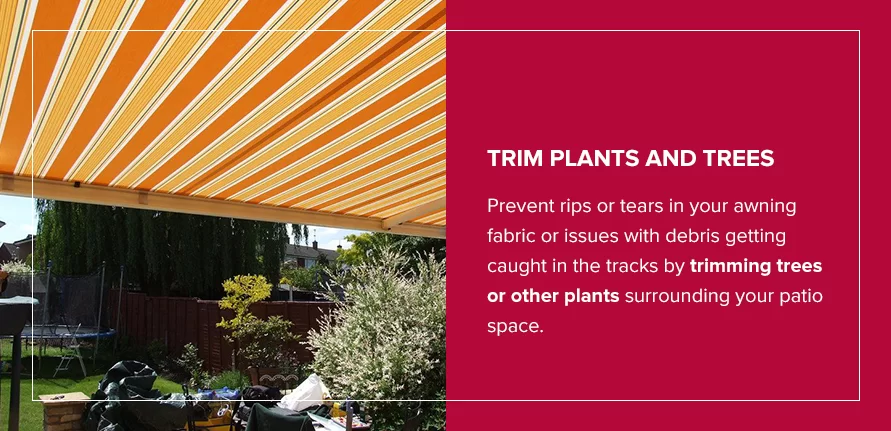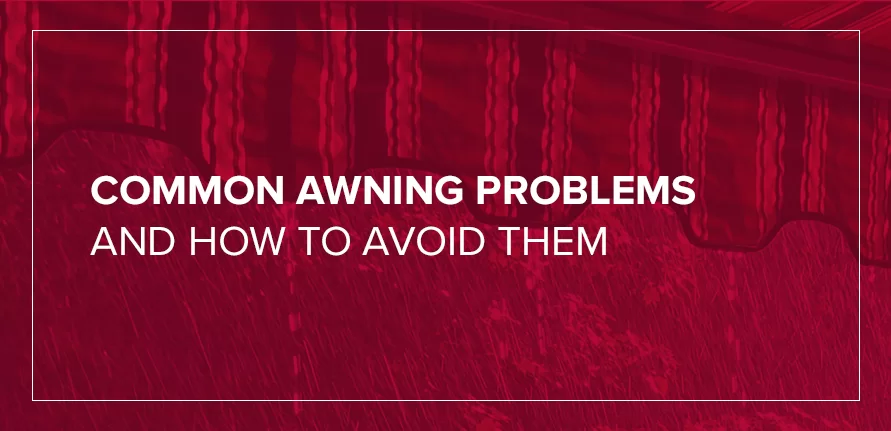
Your home is your space to unwind, host loved ones and create memories with the people in your household. Homeowners put a lot of work into their home’s interior and exterior to make their space feel comfortable. If you enjoy spending time in your yard and want to relax while under a shelter, adding an awning to a space on your deck or patio is a great option.
Awnings are a great addition to any backyard area. This exterior cover will protect you and others from various elements and create a nice hangout space for your home. Awnings are practical and an excellent enhancement to your house’s visual appearance.
If you’re considering adding an awning to your home, it’s helpful to learn how to maintain your new addition, what some of the common awning problems are and how to fix them. Learn more about awnings and why they’re a great residential upgrade.
Reasons You Need an Awning
The two types of awnings homeowners can add to their outdoor space are electrical and manual retractable awnings. For homeowners who enjoy spending time outside, an awning is perfect. In addition to creating a great entertaining space outside, you can benefit from an awning in many ways, including the following:
- Reduce UV damage: You may not notice sun damage inside your home right away, but over time it can dull numerous areas and items inside your home. Some areas the UV rays can impact inside your home include flooring, furniture, wall paint and window treatments. Adding an awning in your yard can protect some windows and anything inside your home that’s visible through the window from sun damage.
- Increase energy efficiency: When the sun shines in through your windows, it can make your home warm up quickly. This can mess with your HVAC system and how it operates, causing it to work harder. If you install an awning over these windows, you can increase your home’s energy efficiency and allow your HVAC system to run easier.
- Boost curb appeal: Numerous home projects and upgrades can boost your house’s curb appeal. An awning is an excellent feature that will make your residence look great and add value to it. With various types of fabrics for home awnings, you can find a look that will best match your style.
- Extend your outdoor living space: You can turn your patio or deck into an extended living space with an awning. Spruce up your outdoor space with furniture, grills, plants and other items that make it welcoming.
5 Most Common Awning Problems
The best thing a person can do once they decide to install an awning is to learn how to maintain it and what the most common retractable awning problems are. Knowing the issues that can happen, from fabric damage to operational errors, can help keep your awning working for a long time.
Check out the five most common awning issues you can troubleshoot or call an expert to provide service for:
1. Sagging
The fabric or material that acts as the shade for the awning should pull tight to provide the best shade on your patio or deck area. As you continue to use your awning, it may begin to sag or droop over time. It may still sag even when you stretch your awning out all the way. It’s important to fix the material so the awning continues to look great and operate properly.
Sagging means your canopy is likely overextended. This problem can be an easy fix by turning the handle that tightens the fabric. Monitor how the material is rolling on the awning mechanism to ensure the solution is simply tightening the canopy.
Another feature that can help stop your canopy from sagging or assist in its functionality is a stabilizer. Adding a stabilizer will allow water to run off without causing the awning to sag and prevent your canopy from moving when it’s windy.
2. Damaged Fabric
Another common problem that people may encounter with their awning is any type of damage to the canopy’s fabric. Since the awning is exposed to outdoor elements, numerous factors can damage the fabric.
Some things that can affect your awning include:
Mold
Your awning will typically be exposed to water and heat from rain or the sun. If your awning doesn’t dry properly before you roll it back up, mold and fungus can start growing. The mold and fungus spots can dull your awning’s appearance. Certain materials are more prone to mold and fungus damage than others, like canvas awnings.
If you notice mold or fungus on your awning, treat the area right away. You can remove the fungus or mold by spraying the fabric with water and applying a mildew removal solution. Ensure the solution fully dries before closing the awning.
Rips and Tears
The durability of the material on your awning ranges, but it’s possible for any type of canopy to rip or tear during regular use.
Tears and rips can happen for numerous reasons, including:
- Quality of craftsmanship
- Wear and tear from the awning’s age
- Debris falling on the awning, like tree branches, rocks and other items
- Loose threads or strings on the awning that catch on something and tear
- Storms and other outdoor elements like rain, hail and snow
You can fix these rips or tears with special tape and patches. Another product you can use to fix these tears includes waterproof adhesive tape. Make sure you cut any loose threads while repairing the holes to prevent others from occurring.
Sun Damage
Your awning helps protect you, your deck and the inside of your home from UV damage. While it protects many areas, the awning’s canopy receives significant sunlight every time you use it. This prolonged sun exposure can dull the fabric and make the awning look less visually appealing.
If you notice the fabric on your awning is faded or has other signs of sun damage, like melted parts in the retracting mechanism, you should start treating it to prevent any further damage. You can do this by applying water and soap to your awning and allowing it to dry fully before storing it. It’s also helpful to speak with a professional and discuss the best fabric choice for your home.
3. Mechanical Problems
Another common retractable awning problem homeowners may face is mechanical issues with the retracting system. Mechanical challenges are common electrical awning issues, but they can also occur with manual awnings. Learning basic troubleshooting knowledge for mechanical issues can help save you time wondering what’s wrong with your awning and enable you to contact a professional for service when you need it.
Some components that experience mechanical problems include:
Sensors
Sensors can produce electric awning problems when they stop working properly. The sensors help retract and extend the awning canopy efficiently and are necessary for the operations of your patio feature. The sensors will respond differently depending on your local weather conditions and other outdoor elements that affect the small pieces of equipment.
A couple of problems with electric awnings that can impact sensor operation include:
- The power going out at your home
- Extended exposure to rain, snow and other elements
If your power goes out while you’re home, you can simply use the manual function to retract and extend your awning. This is helpful when there is extreme weather coming and you want to protect your patio or deck furniture from the elements. This is a temporary fix, so after power is restored, go through possible solutions to your problem or call an expert to inspect your awning.
A professional can determine if the sensors on your awning will need to be recalibrated or replaced. Fixing or replacing sensors is a fairly simple and quick process for a professional to complete, letting you get back to enjoying your awning with less downtime.
Tracks
Electric and manual awning tracks may have problems with closing. Awning tracks are typically made from metal. The tracks allow the awning to easily move to provide a nice shaded space for your deck or patio. When you notice your awning is getting stuck on the tracks or coming off the tracks, you’ll need to have it fixed quickly.
The tracks may need repair for many reasons, like:
- Buildup of debris or dirt inside the tracks
- Warped tracks due to weather and other conditions
- A low amount of lubrication
- The awning has jumped out of the tracks
Clearing out debris or cleaning the tracks is a simple repair, but warped tracks may require more attention. A professional may need to replace the entire track system depending on the state of the tracks. If you’re experiencing electric or manual awning closing problems, it’s helpful to discuss various track options for your awning to see if there is a more durable choice.
Motors
The awning motor is the power source behind the movement of the canopy. The motor allows the awning to extend and retract easily without a hand crank, which is used for manual awnings. When the motor experiences issues or breaks down, it will impact your awning’s functionality.
A broken motor can produce numerous issues for your awning. Other than immobility, the awning can have jerky movements, close or extend slowly or get stuck in an unwanted place. Some reasons you may need to repair your awning motor include:
- Age of the awning
- Physical damage to the motor
- Overheating
While it may be possible for you to move the awning manually, finding a professional to provide a solution for your electric awning is the best option. The repair may be something simple, like a faulty wire or another issue with the motor’s electric connectivity. Other repair options could include replacing broken components in the motor or replacing the entire unit. The specific repair will vary depending on the type of motor and your awning model.
A professional will have the skillset to look at the broken motor, determine what the problem is and provide the best solution for your awning.
4. Environmental Problems
Environmental factors like the weather, animals and the climate can all impact your awning. Forces of nature are unpredictable and will change depending on your location. It’s helpful to consider the possibilities of damages or repairs due to environmental factors and the available solutions to get your awning back up and running.
Environmental problems your awning may encounter include:
Precipitation
Your awning is there to shield you from the outdoor elements, but excessive amounts of inclement weather can start causing problems with its functionality. Weather elements like snow and rain can potentially damage your awning. Your awning’s durability against these weather threats depends on the manufacturer and model, but it’s always best to prepare for weather damage even with the strongest awning.
Excessive rain can cause water to collect in the canopy and add stress to the entire structure. The accompanying issues to look out for with this problem include:
- Pressure on the awning frame
- Warped tracks or frame
- A broken frame, track or other aspects of the awning
- Malfunctions in the motor or other features
Snow is another potential threat to your awning, especially if you live in a cooler climate. Snow can start piling up on your awning and weigh down the canopy. This occurrence can cause issues like:
- Weighed-down canopy fabric
- Holes in awning material
- Added stress on the awning frame
The best thing you can do to protect your awning from rain or snow is to retract it during heavy storms. You can also wipe off snow if it starts building up too high or tilt your awning at an angle to allow rain to flow off.
Wind
Heavy winds can affect your awning and potentially cause damage if the gusts are strong. Sometimes windy conditions are predictable, especially if you live in a part of the country known for windy weather, and you can accommodate for this in advance to avoid damage. Ways that wind can damage the canopy or entire structure of your awning include:
- Tearing holes in the fabric of the canopy
- Causing heavy flapping of the material
Wind damage can be preventable with the proper precautions. Other than keeping an eye out for strong winds, you can protect your awning by:
- Closing it during storms or on windy days
- Selecting a durable awning for your outdoor space before installation
- Using awning accessories like wind poles or a wind sensor
- Setting up a windbreak to protect your awning, like a hedge or fence
A good rule of thumb is that if it’s too windy for you or your guests to sit outside, it’s too windy for your awning. Remember to fully retract it and wait for a better day to enjoy your outdoor space.
If your awning has sustained damage due to wind, a professional technician can help diagnose the problem and provide repair services to get this home feature functioning like normal again.
Bees
Insects like bees can cause trouble if they start to make your awning their home. They can form their nest under your awning and damage the material and frame. They are also bothersome to share your awning space with, so preventing beehives is an essential part of keeping your awning in great shape.
A way to prevent bees and other bugs from congregating in your awning is to clean up any sugary foods or drinks around your outdoor area. Bring in trash cans after gatherings and limit any food supplies outside.
After removing a beehive, you can have a professional inspect your awning to assess any damages.
5. Age
When you’re searching for an awning, it’s best to choose an option that’s durable and built to last. While certain awning models are known to last a long time, age will still leave its mark eventually, and you’ll start to notice repair needs down the road.
Maintaining your awning can help prevent many issues and save you money, but certain age-related problems are hard to avoid.
The most common issues people encounter when they’ve had their awning for a long time include:
- Aesthetic or appearance problems
- Rusty frames or tracks
- Faded canopies
- Electrical issues relating to the motor or sensors
How to Care for Your Awning
Investing in your outdoor space by adding an awning can help make your home more relaxing by providing a cool place to hang out. You want your awning to work whenever you need it, and the best way to ensure this is to regularly care for it with at-home maintenance techniques. From easy tasks like sweeping off the dirt to tending to trees and other brush surrounding your awning, you can keep this valuable home addition in tip-top shape throughout its life span.
Check out the best cleaning and maintenance tasks you can do to keep your awning in working condition.
Clean the Fabric
When you ensure the canopy fabric is always clean, you can count on your awning to stay in great shape for many years. The fabric is the essential feature that shields you from the sun and rain, so practicing the right maintenance techniques can help keep the canopy looking great and working efficiently.
Practice these three simple cleaning steps regularly:
- Sweep off debris: Your awning can collect dirt and other debris that slowly piles up. This can make your awning look dull or potentially cause tears in the fabric. Take a soft bristle brush and sweep off all the debris before washing the fabric.
- Washing the fabric: Start by rinsing your awning with a hose to get rid of any lingering dirt on the canopy fabric. You can also use a mixture of water and mild dish soap to scrub your awning to make the material brighter and cleaner. Consider consulting with a professional to determine the best cleaning products for your type of awning.
- Dry the awning: It’s crucial to let your awning canopy dry completely before retracting it. Doing so will help prevent mold or mildew growth on the damp fabric.
Trim Plants and Trees
Prevent rips or tears in your awning fabric or issues with debris getting caught in the tracks by trimming trees or other plants surrounding your patio space. Look out for any branches that hang over the awning or plants that produce substances that discolor the fabric, such as sap.
Look for Tears
Regularly check for holes or tears in the canopy fabric and repair them right away. Regular repairs can help prevent them from getting bigger and causing you to replace the entire awning canopy.
Practice Other Care Tips
Other helpful care tips for your awning include:
- Use your grill outside of your awning. Using it directly underneath may cause smoke or heat damage to the awning canopy.
- Regularly check the awning frame for any damages.
- Stick with mild cleaning products rather than harsh chemicals.
- Read the manufacturer care instructions for more awning care information.
Schedule Awning Installation or Maintenance Service From Quality Overhead Door
Do you want to improve your outdoor space with an awning? With Quality Overhead Door, you can select from numerous styles, including UV protection awnings and sun sensor models. Our nearly 40 years of experience helps us identify and install the right model for your home so you can enjoy your outdoor space in style. Contact Quality Overhead Door to learn more about our installation services or awning maintenance today.
Additional Resources on Awnings:
- Guide to the Different Types of Awnings
- How to Choose the Right Awning for Your Home
- How to Protect Your Patio from the Elements
- Why Retractable Awnings May Be the Perfect Option for Your Patio

